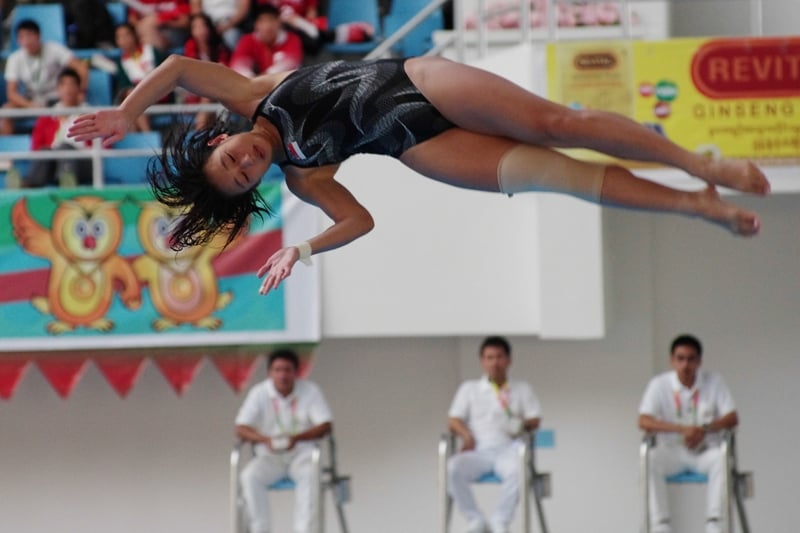Diving rules and techniques
Image credit: Aundry Gan/Sport SG
- Forward Dives
Divers face forward, towards the end of the board, and moves to the end using a forward approach and hurdle. Subsequently, he or she will rotate away from the diving board. - Backward Dives
Divers stands on the end of the board with their back to the water, and after executing a backward takeoff, he or she will rotate away backwards from the springboard. - Inward Dives
Divers stand on the end of the board with their back to the water. The diver then executes a backward press and takeoff, rotating toward the diving board while moving away from it. - Reverse Dives
Also known as a “gainer”, the diver faces forward towards the end of the board and the water. After a forward approach and hurdle, he rotates back toward the diving board while moving away from the diving board. - Twisting Dives
Any dive that incorporates a twist in the body after jumping off the springboard can be considered a twisting dive. This includes dives that are executed from the forward, back, reverse and inward direction, or performed from an armstand. - Armstand Dives
Any dive commencing from a handstand is in the Armstand group. This dive only applies to platform competitions, while the other five apply to both springboard and platform.
Apart from taking note of the various dive groups, the most important aspect of diving is how a diver gets off the diving board or platform. This is why it is key to learn the proper techniques for a forward approach, hurdle, backward takeoff and platform takeoff. - Forward approach
The forward approach refers to the walk a diver takes to the end of the board. A diver should take as many steps as they need to both stay in balance and get the most lift from the board to perform the dive – but this also depends on the type of competition and the set of rules that the competition has. - Hurdle
The hurdle is the last movement for a diver during a forward approach. This comprises of a spring to the end of the board off one foot, followed by landing on two feet at the end of the board. - Backward takeoff
The backward takeoff is the technique used to gain lift and elevation prior to the execution of a backward or inward dive in either springboard or platform diving.
Springboard diving:
In springboard diving, the backward takeoff consists of the use of an arm swing with a leg press - in which the diver pushes himself off the board using his legs - in timing with the vertical movement of the diving board to produce lift.
Platform diving:
Platform diving requires no timing with the platform surface, thus the arm swing is quicker than on the springboard, with inward takeoffs generally eliminating the arm swing altogether.
To receive the latest updates on the happenings in the Singapore sports scene, or to find out more about some of the latest programmes on offer at ActiveSG, like our Facebook page here.





![ActiveSG Academies and Clubs Logo (Solid Colour)[8647]](https://www.activesgcircle.gov.sg/hs-fs/hubfs/ActiveSG%20Circle%202023Theme/images/ActiveSG%20Academies%20and%20Clubs%20Logo%20(Solid%20Colour)%5B8647%5D.png?width=150&height=65&name=ActiveSG%20Academies%20and%20Clubs%20Logo%20(Solid%20Colour)%5B8647%5D.png)



-01.png?width=200&height=141&name=Team%20Singapore%20Logo%20(Red)-01.png)



